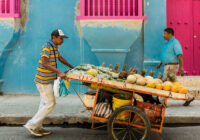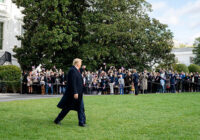Early in the morning on August 28, the former head negotiator for the Revolutionary Armed Forces of Columbia (FARC), Iván Márquez, announced via a YouTube video the official rearmament of a faction of FARC in what appears to be the eastern plains on the Colombian border with Venezuela and Brazil. What does this development imply both for Colombia’s peace process and regional geopolitics?
In the final years of the peace talks that took place in Havana, Cuba, between 2012 and 2016, and especially during the preparation for the FARC’s transition from insurgency to a political party and its reincorporation to civilian life, two wings of leadership coexisted within the armed group. One was led by Rodrigo Londoño, known as Timochenko, with a clear will to move into the political arena. The other was the militarist wing led by Luciano Marín, aka Iván Márquez, which viewed the peace agreement with the Colombian government with mistrust and contemplated a return to armed struggle.
These differences became more evident as the implementation of the peace accord advanced, with several difficulties and delays on the government’s side, especially after the arrival to power of the current president, Ivan Duque, in 2018. The non-fulfillment of several agreements on the governments side — according to the Kroc Institute, after two and a half years, 31% of the agreements have not yet been actioned — and the pressure to secure justice for war crimes committed by the armed group in the course of the decades-long conflict fostered mistrust among military commanders.
A Fracture
Márquez and his right hand in the Caribbean Block of the FARC, Jesús Santrich, are currently subjects of an investigation for alleged involvement in drug trafficking conducted after the signing of the accord, meaning a violation the non-repetition of criminal acts — a key element of the agreement. Currently, FARC combatants are not prosecuted by the ordinary justice system, and the Special Jurisdiction for Peace (JEP) was created for the investigation of war crimes and other atrocities committed during the armed conflict. This means that many of them would either not go to jail at all or serve a maximum of five to eight years. However, in case of recidivism or failing to attend the JEP hearings, former combatants lose all their benefits and can face sentences of up to 60 years.
Although neither of the two men has been prosecuted at the time of the announcement, they had already missed their citations by JEP, widening the divide with Timochenko. After the video was released, the JEP authorized the attorney general to process the rebels through the regular courts and not the transitional justice system as was agreed in Havana.
Smaller dissident rogue groups were being formed by lower ranking leaders such as Gentil Duarte in various regions of the country, but no top member of the FARC’s Secretariat (its highest command structure) has openly deflected the peace process. Márquez will now have to convince leaders like Duarte to join him. What will he offer? The end goal of such an alliance is not clear, as these groups already have weapons, territorial control and established drug routes. What will they do now that they aren’t already doing? Gaining a political halo could be the only clear gain for these rogue criminal groups.
On the other hand, now comes the struggle between the leaders of the political wing who remained within the transition process and the new dissidents. Both sides are pressuring former combatants to join their respective sides, and many are deciding between the path of legality — despite the non-fulfillments and delays of several parts of the agreement — or whether they return to armed struggle. Currently, 90% of the combatants who laid down their weapons are still in the reincorporation process under the leadership of Timochenko. The official data of Colombia’s Reincorporation Agency puts the number as high as 98%.
A New Type of Warfare?
At the same time, according to several sources (including military intelligence), the FARC had never fully given up all of its weapons, and some analysts suggest that the smaller dissident groups that kept up the drug trafficking were coordinated with individual FARC commanders. While there is no proof of this beyond the cases of Márquez and Santrich, there are nearly 1,000 combatants who have rearmed in smaller rogue groups, including the faction led by Márquez.
However, Márquez’s announcement contains a clear insinuation of an alliance with the other main guerrilla group still active in Colombia, the National Liberation Army (ELN). This could mean a bigger threat, as an alliance between the dissident wing of the FARC and the ELN can change the current status quo of armed actors in several regions of the country where there is still a current readjustment of structures after the peace accord. For the last two years, guerrillas and organized crime groups such as the Gaitanistas Self-Defense Forces — the biggest organized crime structure in the country also known as the Gulf Clan — have been dividing their areas of influence and occupying previous FARC zones around the country.
Márquez announced that the faction will change its methods and stop targeting the local population or even soldiers, who, like the guerrillas, come mostly from peasant and lower-class families. The FARC stated that it will target the political, economic and military elites of the country.
For some, this could be a return to the idealistic guerrilla warfare of the 1960s Cold War era, but those who know Márquez better can expect something more than just emulating the glory of old times and the romanticism of the struggle. In the 21st century, with access to advanced weaponry, even a small armed faction can become a serious concern for the country. It could also mean a new time of tension in the cities, instead of open confrontation in the field, reviving the worst of the violence seen in Colombia in the 1990s and the first years of the 21st century. Many are expecting a new era of asymmetrical confrontation.
An Element of Tension
The alliance with the ELN carries not only a national impact, but has also created tensions with the government of President Nicolás Maduro in neighboring Venezuela. As has been stated by several sources within both the media and the Colombian government, the ELN has a strong presence in Venezuela. Its commander, Nicolás Rodríguez Bautista, aka Gabino, and members of the ELN’s central command like the former negotiator Antonio García and Gustavo Aníbal Giraldo, aka Pablito, who lead the strongest structure of the ELN, operate across the border between Colombia and Venezuela.
Colombian intelligence reports estimate nearly 1,000 ELN men and nearly 600 FARC dissident combatants operating from Venezuela. There are no clear statistics, however, and reports suggest the numbers could be even higher. Not all fighters are Colombian, as Venezuelans are also being recruited.
Venezuela’s position regarding the FARC has been ambiguous, especially during the tenures of Álvaro Uribe and Hugo Chávez. Venezuela’s ties with the Colombian guerillas are undeniable, yet in these times of the war against terror, Caracas doesn’t openly admit that it supported the armed group. On the other side, in moments of crisis, Venezuela’s intervention has been useful for dialogue between the Colombian government and the guerrillas. In order words, the neighboring countries are not fully enemies despite the tensions, nor are they allies despite their contributions to the peace process.
Currently, the current administrations both in Caracas and Bogotá are close to their predecessors’ ideologies and, consequently, hostile to their respective neighbors. Maduro’s position is crucial in order not to create more tension in the bilateral relations or increase concerns for the Colombian government regarding what happens in Venezuela. The refugee crisis is escalating in the region, giving Colombia a leading role against Maduro’s embattled regime. While many dismiss a possible clash among the two countries, numerous ongoing crises and provocations could escalate to a breaking point.
President Duque scaled the situation by contacting Venezuela’s interim president, Juan Guaidó, who is currently defying Maduro’s regime, and asked for his support in controlling Colombian guerrillas on Venezuelan territory. To make matters worse, several Colombian high-ranking officials and members of the cabinet have accused the Maduro regime of backing the new armed groups and the ELN guerrillas as a way to destabilize Colombia. Maduro has reacted by ordering military drills along the border.
On September 8, SEMANA magazine published an article that revealed Bolivarian National Intelligence Service documents dated August 9, with evidence of internal orders to provide logistical support and training to “red groups.” According to SEMANA, these alleged “red groups” are in fact Colombian guerrillas. It is important to recall that the date on the documents is two weeks before Márquez’s announcement of the new rebellion. Did the Venezuelan intelligence have privileged information?
Fragile Implementation
Where does this leave the embattled peace process? Not everything should be viewed from an apocalyptic perspective. As already mentioned, the vast majority of the ex-combatants are still active in the reincorporation process, and there is a chance for the Colombian government to send a powerful message by strengthening the Agency for Reincorporation and Normalization as well as other entities in charge of implementation. This might complement the pressure of the expected military response to this not-so-new and expected threat.
Whether these new developments will derail the peace process and complicate regional politics will largely depend on the Colombian government’s response. The situation is escalating: Local elections are coming up in October, and two candidates from different political parties have already been killed. Political participation is one of the keys of the Havana agreement and will become a test for President Duque as well as for the FARC’s political aspirations to win seats across the country; while its chances are not very high, several alliances could make it possible in some areas. Duque will have to protect the voters and candidates as well as prevent any intrusion or indirect interventions of armed actors or neighboring countries.
Last year, the presidential election was the most peaceful in the country’s recent history. It would be catastrophic to face a violent voting season just a year later. Can these new dissidents, plus the border crisis and the remaining armed actors, sabotage what was gained in the peace agreement?
The views expressed in this article are the author’s own and do not necessarily reflect Fair Observer’s editorial policy.
Support Fair Observer
We rely on your support for our independence, diversity and quality.
For more than 10 years, Fair Observer has been free, fair and independent. No billionaire owns us, no advertisers control us. We are a reader-supported nonprofit. Unlike many other publications, we keep our content free for readers regardless of where they live or whether they can afford to pay. We have no paywalls and no ads.
In the post-truth era of fake news, echo chambers and filter bubbles, we publish a plurality of perspectives from around the world. Anyone can publish with us, but everyone goes through a rigorous editorial process. So, you get fact-checked, well-reasoned content instead of noise.
We publish 2,500+ voices from 90+ countries. We also conduct education and training programs
on subjects ranging from digital media and journalism to writing and critical thinking. This
doesn’t come cheap. Servers, editors, trainers and web developers cost
money.
Please consider supporting us on a regular basis as a recurring donor or a
sustaining member.
Will you support FO’s journalism?
We rely on your support for our independence, diversity and quality.






